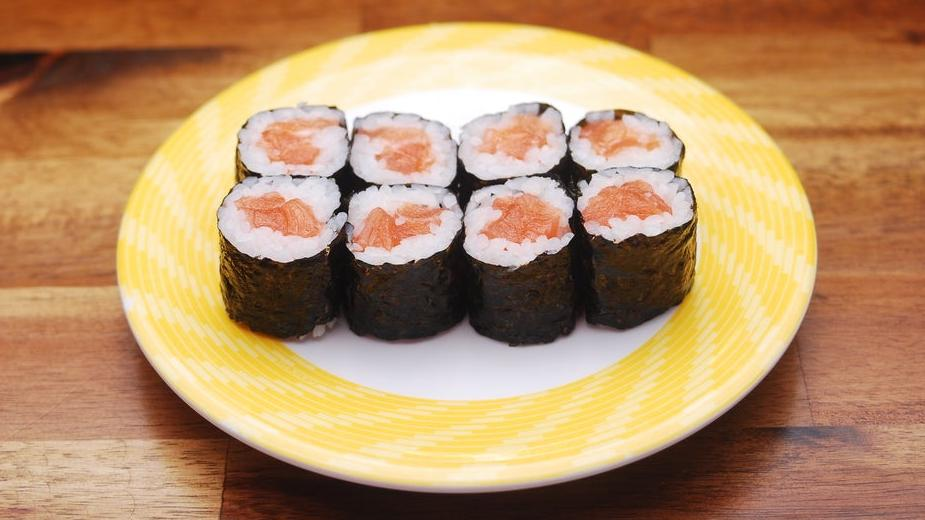It's Okay, You Can (Usually) Trust Small-Town Sushi
Embrace the availability of this beloved coastal favorite.
I've been lucky enough to suffer food poisoning only twice. The first time was at a Shakey's Pizza where, even as a kid, I realized that the dead flies on the buffet were probably a bad sign. The second (and more severe) case was the result of an overripe sushi roll from a well-regarded restaurant just off an interstate highway.
Nevertheless, I still love a good plate of rice and raw tuna. And with advances in freezing and transport methods, I can now find sushi-grade fish at restaurants and grocery stores throughout the rural Midwest. But how safe is this stuff, given its distance from the ocean? And even if it's okay to eat, how can I be sure of the quality?
We have compiled some information and advice on "small-town sushi" below. This is not definitive guide to the culture and cuisine of sushi, nor an argument that Kroger's spicy salmon rolls are on par with the chef's special at BarMasa. Instead, we're focusing on the upside: Sushi is now more available than ever, and arguably safer to eat, too. Most of the time, you can go ahead and enjoy it, as long as you exercise the same caution you would around any other food.
What the heck is “sushi grade”?
When it comes to fish, "sushi grade" is just another marketing catchphrase, like "all-natural" or "farm-raised." But while the term itself may be nebulous, the FDA does have certain handling requirements for seafood intended for raw consumption (and thus worthy of bearing the "sushi grade" tag).
In order for a restaurant to sell uncooked fish, the product must have been caught, bled, and quickly flash-frozen to one of three temperature and time standards. These range from seven days at -4°F to 15 hours at -31°F, as these conditions will kill any parasites that might be attempting to hitch a ride in your dinner.
Then there's the shipping and delivery process. According to Food+City, there's a lot that goes into getting sushi fish to its destination.
The weight of regular ice results in bruising and degradation of the flesh, while dry ice is too extreme to keep fish at a consistent temperature... slicing through ice-packed fish causes it to break apart and gives it a shredded appearance, so whole fish carefully arranged with insulated ice packs is standard.
So if your sashimi looks a bit like pulled pork, something's probably up.
For a real deep dive, head to Serious Eats. There's a lot of great info there, including the reasons why you should never eat freshwater fish without cooking it. Like my college roommate did when he decided to make sushi with some bluegills from the river. Bad call, dude.
Let the ingredients speak for themselves
Over the past decade, I've eaten raw fish everywhere from Chicago to the deserts of New Mexico. Selecting a potential destination for sushi is largely a matter of common sense.
First, check out the online reviews. Do you see any mentions of foodborne illness? If there are multiple, credible appearances of such claims, you might want to steer clear.
If you decide to try a new place, use the basics as a measuring stick. First We Feast has an interesting piece on what (and when) to avoid ordering. Spicy, sauced, or mayo-heavy rolls, for instance, can use other ingredients to mask the taste of fish that, while possibly still safe to eat, is past its prime flavor. A simple slice of tuna or salmon can tell you a lot about an establishment and its product before proceeding to the more exotic options.
Oh, and in case you're dining at one of those broadly themed, buffet-style venues, an important note: Avoid any rolls near the hot bar and stick to the lo mein and crab rangoon.
Many grocery stores now offer sushi as part of the deli menu; the cooks are often assembling the product near or behind the display case. Take a look at the counter and prep area. Does it look clean and organized? How are the stickers and dates applied to the packaging? Even though the sushi cooks are usually separately employed subcontractors, pay attention to the cleanliness in the rest of the deli as well. If things look neat and orderly, you're probably good to go.
Pay attention to your senses around sushi
For research, I attempted to visit the two reputable, small-town sushi spots that inspired this article. As luck would have it, the first was closed for the month as the owners visit family overseas, and the other wasn't open on the day I'd set aside. Then I remembered there was a third option in the area, which, for reasons that will become clear, I choose not to name.
I pulled into the lot a little after noon. Though the restaurant opens at eleven each day, none of the exterior lights or signage were lit when I arrived. There were only a handful of customers in the dining room, and a strange, sour smell pervaded the place. I was almost glad when, after five minutes of standing at the host station, no one showed up to seat me. I turned my back and got out of there.
The moral of the story is this: If you get a bad feeling from the venue, the service, or the food itself, don't put that fish in your mouth. Fortunately, these experiences are becoming fewer and farther between, at least as it relates to sushi specifically. Do your research, trust your gut, and sample the basics before ordering the "Love Boat for Two."
